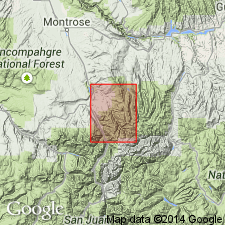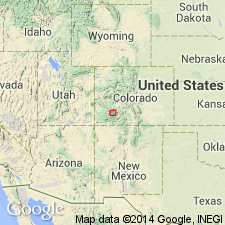
- Usage in publication:
-
- American Flat latite*
- Modifications:
-
- Original reference
- Dominant lithology:
-
- Latite
- AAPG geologic province:
-
- San Juan Mountains province
Summary:
American Flat latite. Light to dark gray porphyritic rock, notable for glistening biotite leaves. Intrusive into Henson tuff, topmost formation of Silverton volcanic series. So closely resembles some of lower flows of Potosi volcanic series that in Silverton folio it was taken as basal flow of that series, but its intrusive character is now evident. [Age is Miocene.]
Its largest known body is that of American Flat, Ouray region, southwestern CO.
Source: US geologic names lexicon (USGS Bull. 896, p. 44).

- Usage in publication:
-
- American Flat Latite*
- Modifications:
-
- Age modified
- AAPG geologic province:
-
- San Juan Mountains province
Summary:
Occurs in the Ouray area CO, San Juan Mountain province. Shown on a table as equivalent to the Fish Canyon Tuff which is part of an ash-flow sequence of Oligocene age. Age of American Flat changed to Oligocene.
Source: GNU records (USGS DDS-6; Denver GNULEX).
For more information, please contact Nancy Stamm, Geologic Names Committee Secretary.
Asterisk (*) indicates published by U.S. Geological Survey authors.
"No current usage" (†) implies that a name has been abandoned or has fallen into disuse. Former usage and, if known, replacement name given in parentheses ( ).
Slash (/) indicates name conflicts with nomenclatural guidelines (CSN, 1933; ACSN, 1961, 1970; NACSN, 1983, 2005, 2021). May be explained within brackets ([ ]).

